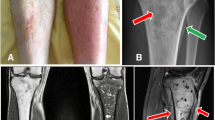Abstract
Intraosseous infusion has become a key tool in the resuscitation of critically ill or injured patients, both in pre-hospital settings and in emergency departments. Intraosseous access is obtained through the percutaneous placement of a needle into the medullary space of a bone, thereby allowing access into the systemic venous circulation via the medullary space, which is essential to treat patients in shock, cardiac arrest, airway compromise, or major trauma. This becomes critically important when obtaining conventional intravenous access is difficult or impossible. Few cases of iatrogenic fracture have been reported for intraosseous access in the tibia and no case to-date has been reported of iatrogenic fracture secondary to humeral access. We report a case of a 55-year-old patient being resuscitated emergently with proximal humeral intraosseous infusion for cardiac and respiratory arrest secondary to status epilepticus. After successful resuscitation and removal of the intraosseous cannula, the patient noted new-onset shoulder pain. The patient was ultimately diagnosed with an iatrogenic fracture of the anatomic neck of the humerus through the intraosseous needle tract when the appropriate history was obtained in conjunction with cross-sectional imaging. As the use of intraosseous access expands, such fractures may well be seen more frequently. Intraosseous access is limited to the period of resuscitation and the cannula is often not present at the time of imaging. It is important for radiologists to recognize the findings related to intraosseous access as well as this complication with its characteristic locations and morphology.





Similar content being viewed by others
References
Drinker CK, Drinker KR, Lund CC. The circulation of the mammalian bone marrow. Am J Phys. 1922;62(1):1–92.
Dubick MA, Holcomb JB. A review of intraosseous vascular access: current status and military application. Mil Med. 2000;165(7):552–9.
Petitpas F, Guenezan J, Vendeuvre T, Scepi M, Oriot D, Mimoz O. Use of intra-osseous access in adults: a systematic review. Crit Care. 2016;20:102.
Committee ECC. Subcommittees and task forces of the American Heart Association 2005 American Heart Association Guidelines for cardiopulmonary resuscitation and emergency cardiovascular care. Circulation. 2005;112(24 Suppl):IV1–203.
Anson J. Vascular access in resuscitation: is there a role for the intraosseous route? Anesthesiology. 2014;120:1015–31.
Link MS, Berkow LC, Kudenchuk PJ, et al. Part 7: adult advanced cardiovascular life support: 2015 American Heart Association guidelines update for cardiopulmonary resuscitation and emergency cardiovascular care. Circulation. 2015;132(18 suppl 2):S444–64.
Soar J, Nolan JP, Böttiger BW, et al. European resuscitation council guidelines for resuscitation 2015: section 3. Adult advanced life support. Resuscitation. 2015;95:100–47.
National Association of EMS Physicians. Position Paper: Intraosseous vascular access in the out-of-hospital setting position statement of the National Association of EMS Physicians. Prehosp Emerg Care. 2007;11:62.
Butler FK. TCCC updates: two decades of saving lives on the battlefield: tactical combat casualty care turns 20. J Spec Oper Med. 2017 Summer;17(2):166–72.
Teleflex Global Research and Scientific Services, a Division of Clinical and Medical Affairs. 2017 The Science and Fundamental of Intraosseous Vascular Access. Third Edition. Accessed online at https://www.teleflex.com/global/clinical-resources/ez-io/EZ-IO_Science_Fundamentals_MC-003266-Rev1-1.pdf on Nov 3, 2019.
Day MW. Intraosseous devices for intravascular access in adult trauma patients. Crit Care Nurse. 2011;31(2):76–89.
Henson NL, Payan JM, Terk MR. Skelet Radiol. 2011;40:239.
Katz DS, Wojtowycz AR. Tibial fracture: a complication of intraosseous infusion. Am J Emerg Med. 1994;12(2):258–9.
Bowley DM, Loveland J, Pitcher GJ. Tibial fracture as a complication of intraosseous infusion during pediatric resuscitation. J Trauma. 2003;55(4):786–7.
La Fleche FR, Slepin MJ, Vargas J, Milzman DP. Latrogenic bilateral tibial fractures after intraosseous infusions attempts in a 3-month-old infant. Ann Emerg Med. 1989;18(10):1099–101.
Finelli PF, Cardi JK. Seizure as a cause of fracture. Neurology. 1989;39:858–60.
Author information
Authors and Affiliations
Corresponding author
Ethics declarations
Conflict of interest
The authors declare that they have no conflict of interest.
Additional information
Publisher’s note
Springer Nature remains neutral with regard to jurisdictional claims in published maps and institutional affiliations.
Rights and permissions
About this article
Cite this article
Hopp, A.C., Long, J.R., Fox, M.G. et al. Iatrogenic humeral anatomic neck fracture after intraosseous vascular access. Skeletal Radiol 49, 1481–1485 (2020). https://doi.org/10.1007/s00256-020-03462-4
Received:
Revised:
Accepted:
Published:
Issue Date:
DOI: https://doi.org/10.1007/s00256-020-03462-4




